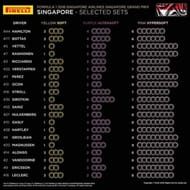The Singapore Grand Prix takes place at the Marina Bay street circuit this weekend and its the only complete night race on F1 calendar so is always an event to watch out for and is a firm favourite among F1 fans around the globe.
Also, we have a very close title battle on our hands, which adds to the fun and games. Sebastian Vettel trails Lewis Hamilton by 30 points in the driver's championship while Ferrari trail Mercedes by 25 points in the Constructor's championship, so its high time that Ferrari get their act together.
Interestingly, The Italian Marquee Ferrari has chosen a very aggressive tyre strategy for the upcoming grand prix, with just 1 set of softs, 3 sets of ultra-softs and 9 sets of hyper-soft tyres.
While their main rivals, Mercedes are playing it safe with 3 sets of softs, 4 sets of ultra-soft, and 6 sets of hyper-soft tyres.

So, how does this impact the strategy?
The thing is, In Singapore, the pit stop time is longer than usual due to the slower speed limit in the pits, so teams like to avoid making additional stops.
At this point, I would also like to point out the tyre allocation rules for each race weekend:
Each car’s full race weekend allocation consists of 13 sets of dry-weather tyres, four sets of intermediate tyres and three sets of wet tyres.
Pirelli nominate two mandatory sets for each car for the race (which can be of different compounds) and one further set of whichever is the softest compound that can only be used in the Q3 segment of qualifying, but the teams are free to choose the remaining 10 sets.
Over the course of a race weekend the teams have to hand back tyres according to a certain schedule, though they can decide which tyres to give back at the following times:
- One set after the first 40 minutes of FP1
- One set at the end of FP1
- Two sets at the end of FP2 *
- Two sets at the end of FP3
* Unless both FP1 and FP2 are either declared wet or cancelled, in which case one of these sets may be retained by each driver but must be returned before the start of the qualifying.
The two mandatory sets nominated by Pirelli cannot be given back during practice and must be available for use in the race.
Drivers who make it through to Q3 must hand back the set of the softer compound tyres nominated for Q3, and start the race on the tyres with which they set their fastest time in Q2. All other drivers will be able to use the set that is saved for Q3 during the race.
Also, the tyre degradation is on the higher side as a result of higher track temperatures, lots of heavy braking corners and the stop and start nature of the track which demands high traction especially through the rear tyres.
So, it's very strange to see Ferrari opt for such a strategy. Obviously, hyper-softs are gonna be the fastest tyre to be on but the tyre degradation is also very high on the hypers.
One possible rationale behind such a strategy may be down to the tricky track layout, so its like very easy for the drivers to lock-up as there are many heavy braking zones so come the Qualifying, that should give Vettel and Raikkonen advantage as even if they lock-up and flat spot the tyre, they would have enough hypers to get back out and put a lap again.
But come to the race it's gonna be challenging as both Raikkonen and Vettel will at most have 1 set of ultra's to practice on during the practice sessions, So in the race they won't really have an estimate as to how the tyre will perform when compared to Mercedes.
Additionally, with Ferrari just opting for 1 set of softs they can't really get any practice runs on the soft tyres, so come the race if they want to switch on to softs, the drivers will be in a blind territory in terms of the setup and feel from the softs.
The expected laps on a set of Hypersoft is around 15 while the Ultrasofts can deliver 40 but the track temperature in Singapore can get really high which may result in tyre blistering.
The likely strategy for Ferrari will be to start on hypers during their first stint, and then pit in for ultra's for their 2nd stint and finally finish the race on hypers or vice-versa.
But, the thing with this strategy is that it limits alternative options and as previously stated with just one set of soft's, should Ferrari choose to use that in the race they will be at a significant disadvantage when compared to Mercedes or even Red-Bull, with both of the teams having the option to practice on the softs.
All in all, Singapore GP should be a cracker of a grand prix both in terms of strategy and on-track action with a possible chance of rain as well.
